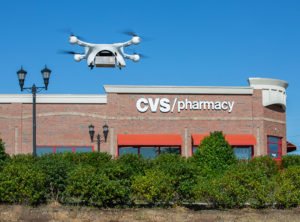At Commercial UAV Expo this morning, a panel of the top players in drone delivery came together to discuss drone delivery in the pandemic. Commercial Drone Alliance Executive Director Lisa Ellman moderated a panel of representatives from top drone delivery companies.
Margaret Nagle, Head of Regulatory Affairs for Wing; Conor French, General Counsel for Zipline; and Kevin Wasik, Head of Business Development at UPS Flight Forward, discussed how things have changed for drone delivery in the pandemic – and what policy changes they’d like to see to move drone delivery forward.
Wing is operating in 3 countries right now: in Australia, the U.S., and Finland. Wing has made tens of thousands of commercial drone deliveries to suburban homes. “We operate much like any other delivery service,” says Nagle. “Customers order on an app… the drone delivers the package to the customer by gently lowering the package to their doorstep.” Nagle says that the areas they service are ready for drone delivery, and anxious to see it expand. “We do a lot of community engagement… we’ve found response to be overwhelmingly positive,” Nagle says. As part of Wing’s participation in the IPP, a study by Virginia Tech is analyzing the impact of drone delivery on service areas – and the results are good. “There are really significant benefits to communities,” says Nagle: benefits include health benefits of people adhering to prescriptions when they don’t have to go out to get them, increased opportunities for local businesses, and significant environmental benefits from saved road travel.
“Zipline is performing 300- 500 deliveries per day,” says French. Zipline is an integral part of the health systems in Rwanda and Ghana. In Rwanda, where Zipline delivers almost 70 percent of the blood supplies distributed in the country, the health outcomes of delivering blood by drone are stunning. Drone delivery has contributed to lowering rates of death from post-partum hemorrhage. “The value to health outcomes and health systems are really significant,” says French.
UPS has been focused since day one on the medical industry. Through their collaboration with Matternet, they’ve been transporting blood samples by drone on the Wake Med campus to allow specimens to be processed sooner. They are now carrying infusion kits for cancer patients – kits with a half life of only 30 minutes. “For a company like UPS we saw the most opportunity within the hospital network – it’s very common for hospitals to be spread out, because they grow over time,” says Wasik. “It’s very common for hospitals to need to use ground couriers. We can really improve efficiencies here.”
Drones in the Pandemic
All of the companies have seen increased interest in drone delivery – and an increased importance for contactless delivery – during the pandemic. “We’ve seen a surge of demand” for services during the pandemic, says Nagle. “We’re pleased to be able to offer some local merchants with the opportunity to reach their customers,” she says.
“We had an obligation to keep operating at full scale during the pandemic – in Ghana, we began immediately to deliver PPE and cleaning equipment,” says French. “In Rwanda, we worked with Partners in Health to deliver long term care programs to cancer patients who couldn’t get out to get them… now in the U.S. we’ve partnered with Novant Health to deliver PPE.”
Wasik agrees that things changed for drone delivery in the pandemic. “There’s a theme here,” says Wasik. “When the pandemic hit, many industries came to a halt… drone delivery kept going and expanded.” UPS Flight Forward has partnered with CVS to deliver prescriptions to the homes of one of the largest senior communities in the country in Florida, servicing close to 200 eligible residents. “There’s a lot of learning happening,” says Wasik. “The pandemic has been an accelerator.”
Still, French points out that as an industry, drone delivery companies should be thinking about how they can help even more in the current crisis. “We’ve really just scratched the surface,” says French. “We need to be thinking about how we can assist with vaccine delivery… it’s so key to getting things back to normal… It’s an industry-wide imperative.”
Policy Challenges
Despite successes, there remain challenges for drone delivery. “The technology has moved so much faster than the policy has,” Lisa Ellman comments. “What changes to we need to see for the technology to scale nationwide?”
While all of the participants emphasize that the FAA has been a very positive partner and has worked hard to help drone delivery move forward, scalability is a major issue.
“It’s still a process of approval by exemption,” says Nagle. “… It’s very time consuming.”
“… how do we make these operations truly scalable, taking them out of smaller operating areas and bringing them to whole cities?” Nagle points out that flight beyond visual line of sight (BVLOS) is a critical component of the process. But, she says,”There isn’t a one size fits all answer to that…there may not be one technology silver bullet.”
French points out that trying to apply existing processes designed for manned aircraft to drones doesn’t always work. “For things like type certification – a drone may be more like a cellphone that’s updated every year, than like an Airbus jet. Multi-year certification processes may not work.”
“Applying processes to drones that were intended for totally different aircraft may not always be the best way,” says French. “We need to move beyond that.”
Wasik points out that UPS has a different background and experience with the FAA, having been operating a commercial airline for over 30 years. “If we had an ask, it would be for a dedicated FAA office for Part 135 drone operations,” says Wasik. “It’s harder to get things done without dedicated resources.”
Despite policy challenges and the current pandemic, the opportunity to hear all of these companies discussing current and future operations made it clear that drone delivery is happening now – and will be expanding rapidly. “The most common question we get from the community,” says Nagle, “is ‘When are you coming to my neighborhood?’”
Miriam McNabb is the Editor-in-Chief of DRONELIFE and CEO of JobForDrones, a professional drone services marketplace, and a fascinated observer of the emerging drone industry and the regulatory environment for drones. Miriam has penned over 3,000 articles focused on the commercial drone space and is an international speaker and recognized figure in the industry. Miriam has a degree from the University of Chicago and over 20 years of experience in high tech sales and marketing for new technologies.
For drone industry consulting or writing, Email Miriam.
TWITTER:@spaldingbarker
Subscribe to DroneLife here.
https://dronelife.com/2020/09/16/drone-delivery-in-the-era-of-the-pandemic-from-the-floor-at-commercial-uav-expo/
 Unmanned Aerial Vehicle The latest drone news
Unmanned Aerial Vehicle The latest drone news


